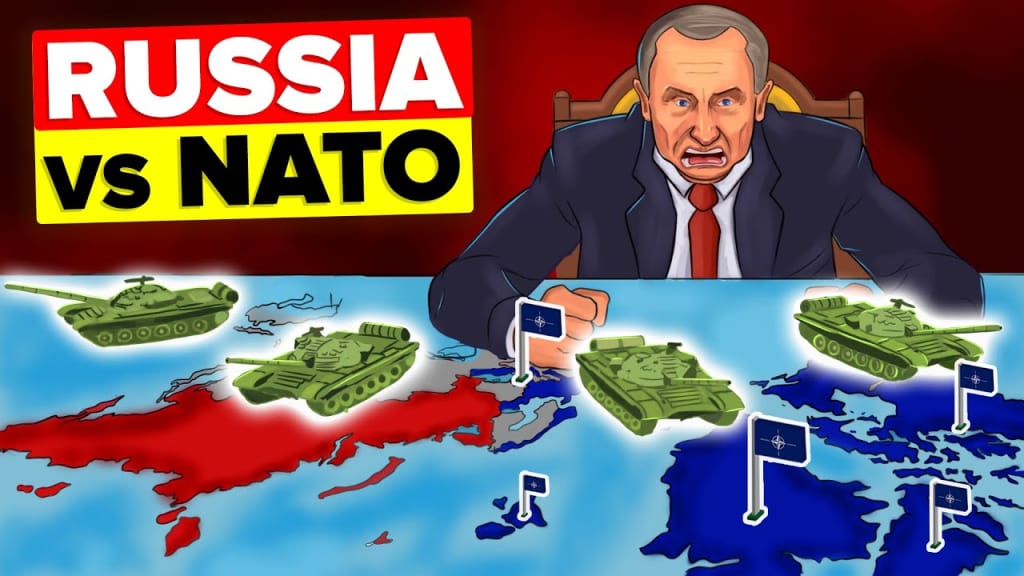When will Russia's heavily armed force be able to take down NATO in a war?
Russia is at odds with NATO in a conflict that might shock the entire planet! With its huge artillery capabilities, could Russia repel NATO forces? Find out in today's amazing new narrative! 🏴☠️💣🤬🏴☠️

Russia is at odds with NATO in a conflict that might shock the entire planet! With its huge artillery capabilities, could Russia repel NATO forces? Find out in today's amazing new narrative! 🏴☠️💣🤬🏴☠️
Field artillery has historically been a major player in every major conflict up until the 21st century, earning the nicknames "King of Battle" in US military circles and "God of War" in the Russian army. However, some essential artillery skills have begun to deteriorate as a result of NATO's involvement in the War on Terror for the past 20 years. Additionally, Russia has gained a lot of tactical knowledge from using massed artillery in four conflicts over the past 20 years. These insights could help Russia defeat its foes. This raises the intriguing question of whether Russian artillery could destroy NATO forces. In terms of raw equipment, the numbers are comparable as of right now. Even though Russia has more towed and self-propelled artillery systems than even the US, when the entire NATO alliance is considered, the numbers are nearly equal.
The equipment's quality makes the biggest difference, though. Modern, lethal self-propelled gun systems include the US 155mm Paladin and German Panzerhaubitze. These are just two examples of the self-propelled weapons NATO could employ to combat Russia, and they both have excellent mobility, long ranges, and sophisticated fire control computers. On the other hand, Russians heavily rely on technology from the Soviet era, which they keep updating to stay current. Russia's frontline battalions and tactical groups are heavily reliant on the 2S19 self-propelled gun. Due to the high number of casualties Russian forces in Ukraine sustained, older models like the 2S5 and 2S1 frequently found their way onto the battlefield.
These vehicles' chassis are frequently 30, 40, or 50 years old, even though their sensors, radars, fire control computers, and munitions have all been updated. This means that when these vehicles sustain battle damage or otherwise malfunction, they must be declared a total loss due to the limited supply chain support for parts. Even when contrasting NATO tube artillery with Russian tube artillery, the situation appears to be slightly worse. Both armed forces still use concepts and equipment from the Cold War. However, due to financial constraints, Russia has continued to use the majority of these designs because it is unable to afford to support the development of more modern systems. Older tube artillery has been kept in stock by US and NATO nations primarily because newer systems are not necessary.
Instead, NATO nations have made significant investments in developing communications, munitions, and fire control technology. These innovations aspire to make these weapons the world’s most accurate. For instance, GPS and laser-guided munitions like the Excalibur or Copperhead have established themselves as standard items in NATO arsenals. Accuracy has increased thanks to the emphasis on precision-guided munitions, but costs have skyrocketed. The US and NATO have been prevented from assembling significant shell stockpiles due to the high cost of these rounds, which frequently carry a price tag of 80,000 dollars or more per round. Due to its precision-guided weapons, NATO would have a slight advantage over Russia, but a victory is still not guaranteed.
This is due to the way Russia trains and deploys its artillery forces. The way the two ground forces employ artillery is one of their main differences. In NATO nations, advancing infantry forces are supported by artillery fire. Infantry advances are made in the Russian army to secure advantageous vantage points from which Russian artillery can fire down on the opposition. This is because, in contrast to NATO members, Russia uses its towed and self-propelled artillery primarily for direct fire operations. Artillery batteries are capable of carrying out a variety of different fire missions. According to Western doctrine, there are five main types of fire missions, which can then be further divided into offensive and defensive operations.
Precision munitions are typically used in long-range artillery fires in the NATO armed forces. There are several advantages to these kinds of fire missions. The first benefit is that they shield artillery crews from counterbattery fire. An enemy may engage in counterbattery fire to destroy an opponent's artillery positions, since they are less physically vulnerable than if they were closer to the frontlines, crews have more time to correct their fires at longer ranges. However, due to their reliance on precision-guided weapons, these operations have a slow rate of fire and high overall costs. The exact opposite is true, according to Russian doctrine. The Russians primarily employ direct fire with all of their artillery systems.
Direct fire occurs when a gun crew can see an enemy target with their own eyes. This kind of engagement typically occurs between a few hundred meters and a few kilometers away. Because they prioritize direct fire, Russia keeps its artillery very close to the front lines, usually only two to six kilometers behind the forward positions. In practice, this means that artillery crews can receive feedback directly from frontline soldiers rather than having to play telephone with a forward observer, a fire control center, and each individual battery, as is the case in NATO militaries. Since NATO nations only teach direct fire as a last resort, Russia has a distinct advantage over NATO armies. It's a strategy that Russia frequently uses because it works well.
Due to its involvement in World War II, Russia developed a preference for direct fire. The Soviet artillery specialized in direct fire support for the majority of the conflict. 80 Soviet artillery pieces were being used in direct fire roles by the end of the war, including in the Battle of Berlin. If asked to carry out such tasks, NATO gunners would not be prepared. In most cases, their equipment wouldn't even make it possible. For instance, the US M109A6 and M109A7 Paladin, the cornerstone of Western self-propelled guns, lack even a direct-fire gun sight on their barrels. Crews would have to sight targets directly down the barrel, which is at best inaccurate, if they were required to complete this task. A further advantage over NATO's sheer volume would belong to Russian artillery.

Certified. You're definitely going to miss out.
Make sure to always be updated. Possibly daily. 😁
About the Creator
Enjoyed the story? Support the Creator.
Subscribe for free to receive all their stories in your feed. You could also pledge your support or give them a one-off tip, letting them know you appreciate their work.






Comments
There are no comments for this story
Be the first to respond and start the conversation.